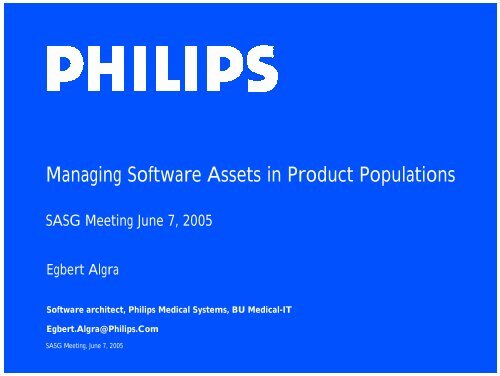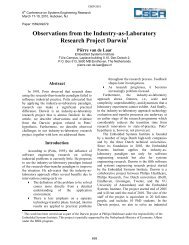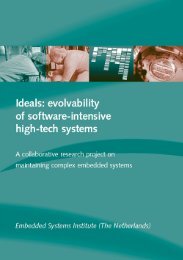SCM variant version management
SCM variant version management
SCM variant version management
You also want an ePaper? Increase the reach of your titles
YUMPU automatically turns print PDFs into web optimized ePapers that Google loves.
Managing Software Assets in Product Populations<br />
SASG Meeting June 7, 2005<br />
Egbert Algra<br />
Software architect, Philips Medical Systems, BU Medical-IT<br />
Egbert.Algra@Philips.Com<br />
SASG Meeting, June 7, 2005
Overview<br />
• PMS introduction<br />
• Problem introduction<br />
• Approach<br />
– Things that work<br />
– Problems that remain<br />
• Conclusion<br />
Philips Medical Systems, Egbert Algra, SASG Meeting 07/06/2005<br />
2
Introduction: PMS company<br />
• Employees: 30.000<br />
• Development sites:<br />
– The Netherlands: Best and Heerlen<br />
– Finland: Helsinki<br />
– Germany: Hamburg and Böblingen<br />
– Israel : Haifa<br />
– USA: Bothell and Seattle, Washington; Reedsville and Philadelphia,<br />
Pennsylvania; Andover, Massachusetts; Milpitas and Oxnard, California;<br />
Cleveland, Ohio; Chicago, Illinois<br />
• Considerable growth<br />
– Doubled in size last 5 years<br />
– More organic and acquisition growth anticipated<br />
Philips Medical Systems, Egbert Algra, SASG Meeting 07/06/2005<br />
3
Introduction: PMS products<br />
• Medical Imaging equipment (“modalities”)<br />
– X-ray<br />
– Ultrasound<br />
– Magnetic resonance<br />
– Computed tomography<br />
– Nuclear medicine, PET,<br />
– Radiation oncology systems<br />
– Patient monitoring<br />
– Information <strong>management</strong> and resuscitation products.<br />
• Services (training and education, business consultancy,<br />
financial services and e-care business services)<br />
• Worldwide market share in Top-3 segments<br />
– (competing GE and Siemens)<br />
Philips Medical Systems, Egbert Algra, SASG Meeting 07/06/2005<br />
4
Product samples<br />
Philips Medical Systems, Egbert Algra, SASG Meeting 07/06/2005<br />
5
Product trends<br />
• Combined products<br />
– Combined products (CT/PET, MR/Xray)<br />
–HW and SW<br />
• Including the ‘SW only’ parts<br />
• Similarity towards the end-user<br />
– User interface ABC<br />
• Appearance, Behaviour, Concept<br />
• Hospital integration<br />
– Similar clinical tasks at various workspots<br />
• Scanner, Operator console, Workstation, Office<br />
• Challenge: (re)use same SW components<br />
– In the various product families<br />
Philips Medical Systems, Egbert Algra, SASG Meeting 07/06/2005<br />
6
Problem Description<br />
• Managing the medical imaging software assets as<br />
deployed in various product families<br />
– Assets: Medical imaging workspot for digital image handling<br />
and advanced clinical processing<br />
• Multi modality viewing (X-ray, MR, CT, US, NM)<br />
• Clinical image post processing and analysis<br />
• Clinical reviewing and reporting applications<br />
– Deployment on a variety of product families<br />
• Acquisition console<br />
• Advanced clinical processing workstation<br />
• PACS viewing client<br />
Philips Medical Systems, Egbert Algra, SASG Meeting 07/06/2005<br />
7
Relevance & Benefits<br />
• Software assets represent significant value (3+<br />
MLOC), and are created at significant cost<br />
(300+ man-years).<br />
• Product families approach:<br />
– Improves time-to-market<br />
– Reduces development and maintenance costs<br />
– Promotes common product ‘look-and-feel’ for the<br />
same functions on different products<br />
Philips Medical Systems, Egbert Algra, SASG Meeting 07/06/2005<br />
8
Scope: operational aspects<br />
• Operational aspects<br />
– Requirements <strong>management</strong><br />
– Architecture<br />
–Variation<br />
– Project <strong>management</strong><br />
• Out of scope<br />
– Business aspects<br />
• Who Control<br />
• Financials<br />
– Organizational aspects<br />
• Component/platform groups versus product development groups<br />
Philips Medical Systems, Egbert Algra, SASG Meeting 07/06/2005<br />
9
Approach overview:<br />
software asset variation <strong>management</strong><br />
• Requirements<br />
– How to manage varying asset requirements for the different target<br />
deployment system (of which some are conflicting)?<br />
• Architecture<br />
– How to deploy assets on different product system architectutes?<br />
– How to manage the variation in ‘standards’ implementations?<br />
– How to manage the creation of the various asset <strong>variant</strong>s from the<br />
source base?<br />
• Lifecycle<br />
– How to maintain the specific asset <strong>version</strong>s that are deployed in<br />
products?<br />
Philips Medical Systems, Egbert Algra, SASG Meeting 07/06/2005<br />
10
Requirements approach:<br />
requirements <strong>management</strong> variations<br />
• Experience: requirements vary for different<br />
deployment systems.<br />
– All asset requirements are gathered in a single<br />
requirements database (Rational RequisitePro)<br />
– Each requirements is equipped with ‘attributes’ identifying<br />
the applicable <strong>variant</strong>s<br />
– The complete set of requirements from an asset <strong>variant</strong> is<br />
generated by a ‘query’ on the database<br />
Philips Medical Systems, Egbert Algra, SASG Meeting 07/06/2005<br />
11
Example:<br />
requirements <strong>management</strong> variations<br />
• Asset requirements have attributes for applicable <strong>variant</strong>s<br />
(PC, MX, DX) and <strong>version</strong>s (3.1, 3.2, …)<br />
Philips Medical Systems, Egbert Algra, SASG Meeting 07/06/2005<br />
12
Architecture approach:<br />
product system architecture standardization<br />
• Definition of PMS shared (software) product<br />
architecture (SPA)<br />
– Provided and required interfaces<br />
– Information models<br />
• Definition of PMS-wide information models, enabling<br />
the exchange and sharing of medical (imaging) data<br />
and system configuration data<br />
• Assets adhere to the agreed interfaces and<br />
information models, and can be used within other<br />
PMS products<br />
Philips Medical Systems, Egbert Algra, SASG Meeting 07/06/2005<br />
13
Example:<br />
product architecture standardization<br />
Configuration<br />
DAI<br />
CIM<br />
SSI<br />
ILogging<br />
Logging Asset<br />
SystemServices<br />
Repositories<br />
Repositories<br />
Performers<br />
Performers<br />
Repositories Clinical services<br />
Performers<br />
Philips Medical Systems, Egbert Algra, SASG Meeting 07/06/2005<br />
SPA<br />
Compliant<br />
Application<br />
DAI PIIM ICI ICIM JHI PIM<br />
Data Access Clinical Service<br />
FSI<br />
Job Handling<br />
FieldService<br />
14
Known issue 1:<br />
Standards evolve<br />
• Standards (interfaces) change over time<br />
– Sources:<br />
• New use-cases,<br />
• New requirements<br />
• Changing requirements<br />
• Changing/evolving external standards (DICOM)<br />
• Policy<br />
– Introduce only backwards compatible changes<br />
• Additional interfaces<br />
• Data model extensions<br />
– Manage the changes<br />
• Organisation of change-control boards<br />
• Documentation<br />
Philips Medical Systems, Egbert Algra, SASG Meeting 07/06/2005<br />
15
Known issue 2:<br />
Implementation of the standard vary<br />
• Interface implementations deviate from standards<br />
– Differences in standards interpretation (behavior!)<br />
– ‘Bugs’ in released systems<br />
• Approach: introduce ‘layers’ between the asset and the<br />
infrastructure interface implementation<br />
– Internals of the software asset is based on ‘abstraction layer’ to the<br />
interface<br />
– Variations in interface implementation are managed in the interface<br />
abstraction layer.<br />
• Stable internal privately managed interface of ‘standards’ towards core<br />
asset component<br />
• Variation of ‘real’ standards is mapped to internal interface<br />
• Maps ‘system plumbing’ interfaces into convenient ‘Asset API’<br />
Philips Medical Systems, Egbert Algra, SASG Meeting 07/06/2005<br />
16
Known issue 3:<br />
Usage of incompatible component technologies<br />
• Components are created using various technologies<br />
– C/C++/Objective-c, Java, .NET, …<br />
– Where the systems integrate the tech<br />
• Approach: middleware technology<br />
– COM as ‘glueware’ between technologies<br />
– ‘Glueware layers’ hiding the COM details to the assets<br />
• And removing the glueware whenever possible<br />
• Proven for various technologies<br />
– Java, .NET, C/C++/Objective-C<br />
Philips Medical Systems, Egbert Algra, SASG Meeting 07/06/2005<br />
17
Interface abstraction layer<br />
Philips Medical Systems, Egbert Algra, SASG Meeting 07/06/2005<br />
Asset<br />
core<br />
implementation<br />
Interface abstraction<br />
layer<br />
Glueware abstraction<br />
layer<br />
Interface Info model<br />
Infrastructure<br />
Component<br />
18
Known issue 4:<br />
Side-by-side deployment and <strong>version</strong>ing<br />
• Multiple <strong>version</strong>s of a ‘common’ library or<br />
component on a single system<br />
– Both ‘own’ components and 3 rd party.<br />
• Approach<br />
– Microsoft .NET assembly <strong>version</strong>ing<br />
• (only solves part of the problem)<br />
– We still need to gain experience here!<br />
Philips Medical Systems, Egbert Algra, SASG Meeting 07/06/2005<br />
19
Architectural approach:<br />
Software asset <strong>variant</strong> creation<br />
• A single source-code base from which all assets are<br />
created<br />
– With identified variation points at different levels<br />
• Compile time (e.g. makefiles resulting in different executables or<br />
libraries for the <strong>variant</strong>s)<br />
• Installation time (e.g. COM registration of different component<br />
<strong>variant</strong>, installation of different set of configuration property files)<br />
• Configuration time (e.g. product engineering, service or end-user<br />
configuration elements)<br />
• Run time (e.g. hardware availability based variation)<br />
Philips Medical Systems, Egbert Algra, SASG Meeting 07/06/2005<br />
20
Example: from sources to assets<br />
SourceFile A<br />
SourceFile B<br />
Makefile X<br />
Makefile Y<br />
Items under <strong>SCM</strong><br />
Philips Medical Systems, Egbert Algra, SASG Meeting 07/06/2005<br />
Asset <strong>variant</strong> X<br />
PropertyFile X<br />
Asset <strong>variant</strong> Y<br />
PropertyFileY<br />
Installer Y<br />
Installer X<br />
Product X<br />
Product Y<br />
DeploymentAsset X<br />
PropertyFile<br />
DeploymentAsset Y<br />
Property File<br />
Run-tim e<br />
initialisation<br />
21
Architectural variation programming<br />
guidelines<br />
• Program ‘capability-driven’ I.s.o. <strong>variant</strong> driven<br />
– Avoid explicit ‘<strong>version</strong>-checks’ in software<br />
• “If (<strong>version</strong> == SystemA) then Enable store function”<br />
– Instead program ‘capability’ or ‘property’ dependent<br />
• “If (database.IsWritable) then Enable store function”<br />
• Or: “If (Properties.EnableDatabaseWrite) then …”<br />
• Design variation mechanism up-front<br />
– Choose the requ<br />
– Balancing flexibility and transparency<br />
• Minimize amount of <strong>variant</strong>-specific code<br />
Philips Medical Systems, Egbert Algra, SASG Meeting 07/06/2005<br />
22
Lifecycle Approach:<br />
<strong>SCM</strong> <strong>variant</strong> <strong>version</strong> <strong>management</strong><br />
• Rational ClearCase <strong>version</strong> <strong>management</strong> of the<br />
released <strong>variant</strong> <strong>version</strong>s<br />
– As an identifiable branch of the sources<br />
– Self-contained, including the build- and installation<br />
environment<br />
– With tool support for merging fixes from one <strong>version</strong> to<br />
another<br />
• In a single ‘mainline’ stream all <strong>variant</strong> changes are<br />
integrated to prevent di<strong>version</strong>s.<br />
Philips Medical Systems, Egbert Algra, SASG Meeting 07/06/2005<br />
23
Example<br />
<strong>SCM</strong> <strong>variant</strong> <strong>version</strong> <strong>management</strong><br />
Bug fix<br />
Variant A<br />
Version 1<br />
Philips Medical Systems, Egbert Algra, SASG Meeting 07/06/2005<br />
Variant B<br />
Version 1<br />
Variant A<br />
Version 2<br />
EndOfLife<br />
Variant B<br />
Version 2<br />
mainline<br />
time<br />
24
Lifecycle Approach:<br />
Project <strong>management</strong><br />
• Development projects delivering an update of<br />
multiple <strong>version</strong>s of an asset<br />
• Issues<br />
– Product validation (testing)<br />
– Product documentation<br />
• Design, testing<br />
• Merging<br />
• No “silver bullets”<br />
Philips Medical Systems, Egbert Algra, SASG Meeting 07/06/2005<br />
25
Conclusion and Outlook<br />
• Variation is inevitable, so be prepared.<br />
• An integral approach to manage asset variation is<br />
required<br />
– Requirements Management<br />
– Product Architecture<br />
– Asset creation variation points<br />
– Software Configuration Management<br />
• Useful commodity development tooling is available<br />
to assist the variation <strong>management</strong>.<br />
• Project <strong>management</strong> of asset <strong>variant</strong> development is<br />
topic for future considerations.<br />
Philips Medical Systems, Egbert Algra, SASG Meeting 07/06/2005<br />
26
Credits<br />
Part of this work has been carried out in the<br />
context of a EU project<br />
• Eureka! 2023 Programme,<br />
– ITEA project ip02009,<br />
• FAMILIES<br />
• http://www.esi.es/en/Projects/Families/<br />
Philips Medical Systems, Egbert Algra, SASG Meeting 07/06/2005<br />
27







